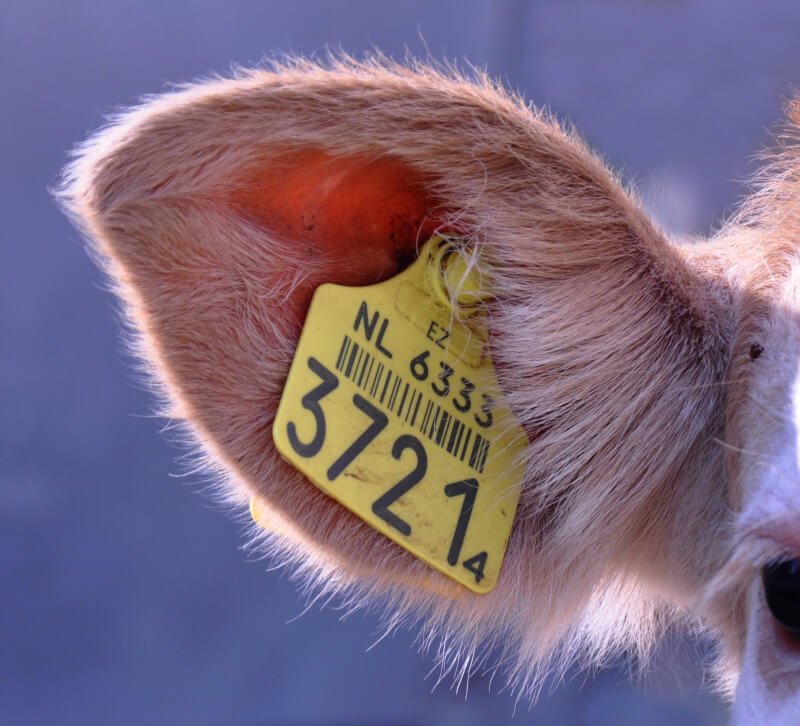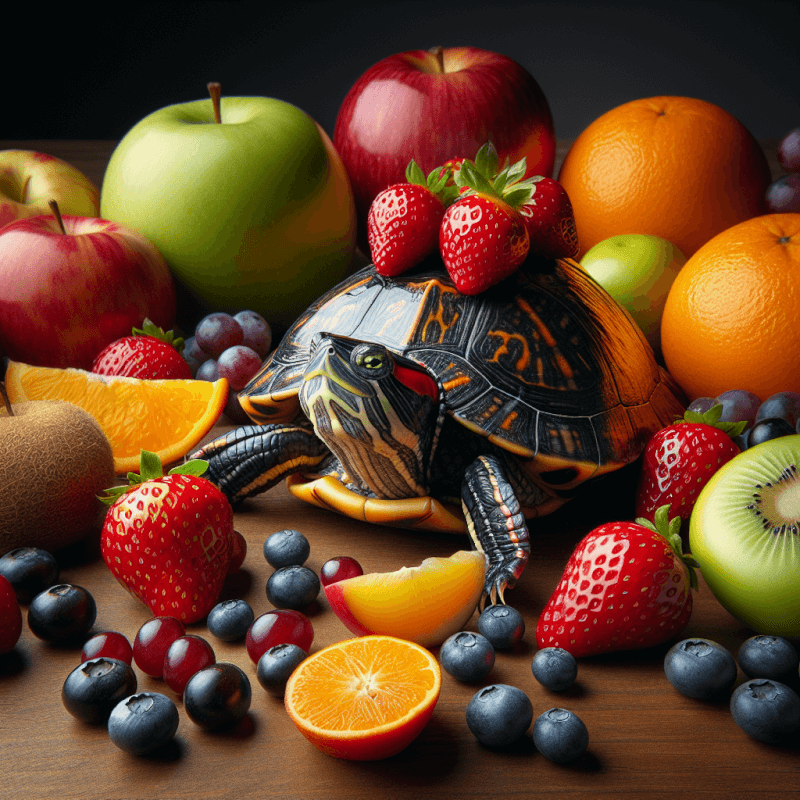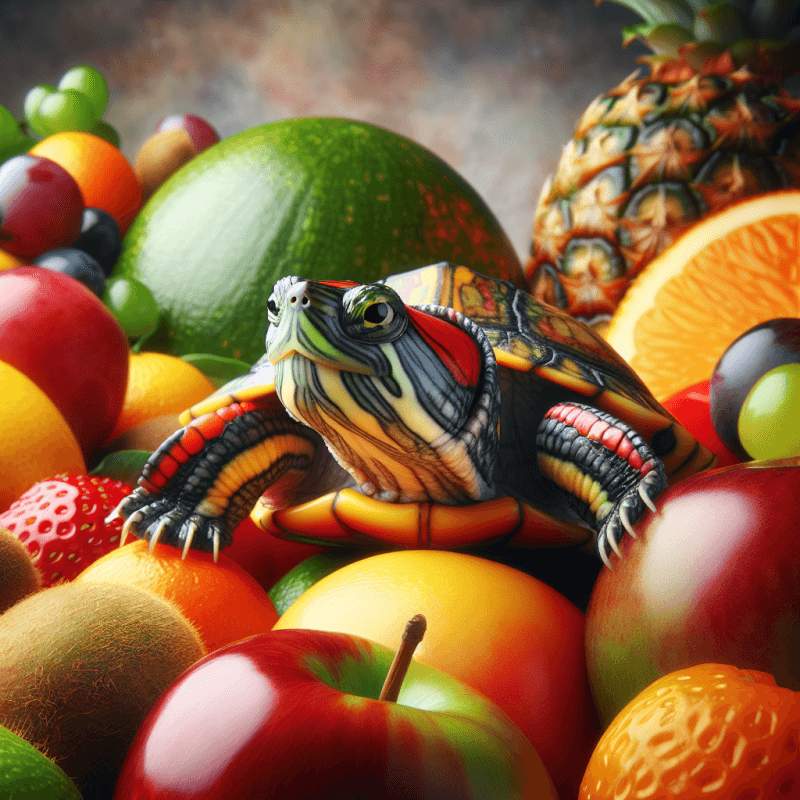Are you curious if red-eared sliders can indulge in a bit of fruity goodness? Well, the answer might surprise you! While red-eared sliders are primarily omnivorous, with their diet consisting mainly of aquatic plants and small vertebrates, they can indeed enjoy fruits as a tasty treat every now and then. However, it’s important to note that fruits should not be a staple in their diet, as they require a more balanced and varied menu to thrive. So, let’s dig in and explore the dos and don’ts of feeding fruits to our shelled friends!
Overview of Red-Eared Sliders
Red-eared sliders are popular pet turtles known for their vibrant red stripes on their heads and distinctive red patches behind their eyes. These turtles are native to southeastern parts of the United States and are widely distributed in various habitats such as ponds, lakes, and slow-moving rivers. Red-eared sliders have a diverse diet, which includes both plant and animal matter. While they primarily consume insects, crustaceans, and aquatic vegetation in the wild, they can also enjoy a variety of fruits as part of their balanced diet in captivity.
Physical Characteristics
Red-eared sliders have a smooth, oval-shaped shell with a green or olive color. As they age, their shells may darken and develop small lines or ridges. The average size of an adult red-eared slider ranges from 7 to 12 inches in length, with females being larger than males. These turtles have a sharp beak-like mouth and webbed feet, which make them excellent swimmers.
Habitat and Distribution
Red-eared sliders are primarily found in the southeastern parts of the United States, including regions such as Mississippi, Louisiana, Texas, and Florida. However, due to their popularity as pets, they have been introduced to various parts of the world. In terms of habitat, they prefer slow-moving bodies of water, such as ponds, lakes, and marshes, where they can easily bask on rocks or logs to regulate their body temperature.

Feeding Habits
Red-eared sliders are opportunistic omnivores, meaning they eat a variety of both plant and animal matter. In the wild, their diet consists mainly of insects, fish, snails, crustaceans, and aquatic vegetation. However, in captivity, it is important to provide them with a balanced diet that meets their nutritional requirements.
Natural Diet
The natural diet of red-eared sliders includes a combination of animal protein, such as insects and crustaceans, and plant matter, including various aquatic plants. They are also known to occasionally feed on small fish and carrion. This diverse diet helps them obtain the necessary nutrients for their growth and overall health.
Nutritional Requirements
When feeding red-eared sliders, it is important to ensure that their diet meets their nutritional requirements. These turtles require a balance of protein, vitamins, minerals, and fiber for optimal health. Protein is crucial for their growth and development, while vitamins and minerals support their immune system and overall well-being. Fiber aids in digestion and prevents issues like constipation.

Recommended Food Items
To meet the nutritional needs of red-eared sliders, a combination of commercially available turtle pellets, fresh vegetables, and fruits can be provided. Some recommended food items for red-eared sliders include:
Commercial turtle pellets: These are specifically formulated to provide the necessary nutrients for turtles. Choose high-quality pellets that contain a balanced mix of protein, vitamins, and minerals.
Leafy greens: Vegetables like kale, collard greens, and dandelion leaves are excellent sources of vitamins and minerals. These can be offered either raw or steamed for easy consumption.
Can Red-Eared Sliders Eat Fruits?
Yes, red-eared sliders can eat fruits, but they should be incorporated into their diet in moderation. While fruits may not be a natural part of their diet in the wild, they can provide additional nutrients and variety to their meals. However, it is important to be cautious about the types of fruits offered and the frequency of their consumption.
Advantages of Feeding Fruits
Including fruits in a red-eared slider’s diet can have several benefits. Fruits are a good source of vitamins, antioxidants, and natural sugars. They can provide a refreshing treat for your turtle and help prevent boredom. Furthermore, certain fruits contain high water content, which contributes to hydration, especially during warmer months.

Disadvantages of Feeding Fruits
While fruits offer nutritional benefits, they should never be the primary component of a red-eared slider’s diet. Excessive consumption of fruits can lead to imbalances in their diet, as they may not receive enough protein and other essential nutrients. Additionally, some fruits are high in natural sugars, which, if consumed in excess, can lead to weight gain, digestive issues, or even diabetes in turtles.
Safe and Healthy Fruits
When feeding fruits to red-eared sliders, it is crucial to select safe and healthy options. Fruits with a high water content, such as melons and berries, can be a good choice. Examples of safe fruits for red-eared sliders include:
- Watermelon
- Cantaloupe
- Blueberries
- Strawberries
- Papaya
Fruits to Avoid
While some fruits are safe for red-eared sliders, there are certain fruits that should be avoided due to their potential toxicity or adverse effects on turtles. Avoid feeding the following fruits to your red-eared slider:
- Grapes and raisins: These fruits can be toxic to turtles and may cause kidney damage.
- Citrus fruits: Oranges, lemons, and other citrus fruits are acidic and can cause digestive issues in turtles.
- Avocado: Avocados contain a harmful toxin called persin, which can be toxic to turtles.
- Banana: While bananas are not toxic to turtles, they are high in phosphorus and may disrupt the calcium-phosphorus balance if fed too often.

Proper Feeding Practices
When it comes to feeding fruits to red-eared sliders, it is important to follow proper practices to ensure their health and well-being.
Moderation in Fruit Intake
Remember to offer fruits in moderation. Fruits should never make up more than 10% of your red-eared slider’s total diet. The majority of their meals should consist of high-quality turtle pellets and fresh vegetables.
Variation in the Diet
Offer a variety of fruits to add diversity to your red-eared slider’s diet. This helps ensure they receive a broad range of nutrients. Rotate between different safe fruits, ensuring your turtle gets a balanced diet.

Avoiding Toxic Fruits
Be cautious and avoid feeding toxic fruits to your red-eared slider. Stick to safe and healthy options to prevent any potential harm or adverse reactions.
Supplementing with Other Foods
In addition to fruits, red-eared sliders can benefit from other food items that provide essential nutrients. This can include proteins like mealworms, earthworms, and cooked lean meats. Additionally, offering a mix of vegetables such as dark leafy greens, carrots, and bell peppers can provide further nutritional variety.
Feeding Fruits to Baby Red-Eared Sliders
When it comes to baby red-eared sliders, their diet should primarily consist of easily digestible proteins and a small amount of vegetables. While fruits can be introduced gradually, it is important to follow these guidelines:
Age-Appropriate Fruits
As baby turtles have delicate digestive systems, it is advisable to wait until they are at least six months old before introducing fruits. Start with small, soft fruits that are easy for them to chew and digest.
Introducing Fruits to Their Diet
When introducing fruits to baby red-eared sliders, offer small pieces initially, and observe their response. If they show any signs of digestive issues or discomfort, discontinue feeding fruits for a while and consult a veterinarian if needed.
Handling and Preparation
Always wash fruits thoroughly before feeding them to your baby red-eared slider. Remove any seeds, pits, or tough skin that they may have trouble digesting. Cut the fruits into small, bite-sized pieces to make it easier for them to eat.
Signs of Fruit Allergy or Intolerance
While red-eared sliders can generally tolerate fruits in moderation, some individuals may have allergies or intolerances to certain fruits. It is important to be aware of the signs of a potential fruit allergy or intolerance in your turtle.
Common Symptoms
Watch for signs such as excessive scratching, swelling, redness, or hives on the skin, or digestive issues like diarrhea or vomiting. If you notice any of these symptoms after feeding fruits, it is advisable to discontinue offering fruits and consult a reptile veterinarian for guidance.
Seeking Veterinary Assistance
If you suspect your red-eared slider is experiencing an adverse reaction to fruits or any other food, it is important to seek veterinary assistance. A reptile veterinarian can evaluate your turtle’s condition and provide appropriate advice or treatment if needed.
Other Considerations
There are a few additional factors to consider when feeding fruits to red-eared sliders:
Fruit Size and Preparation
When offering fruits to your turtle, ensure that the pieces are appropriately sized for them to consume without difficulty. Large pieces may cause choking hazards. Additionally, removing any seeds or pits that may be harmful or hard to digest is crucial.
Organic vs. Non-Organic Fruits
While organic fruits are generally considered a healthier option for humans, the same does not necessarily apply to red-eared sliders. As long as non-organic fruits are properly washed and free from pesticides or harmful chemicals, they can be safely offered to your turtle.
Seasonal Availability
Some fruits may not be available year-round or may vary in quality during different seasons. This can affect their nutritional value. Whenever possible, choose fresh, ripe fruits that are in season for optimal nutritional benefits.
Conclusion
In conclusion, red-eared sliders can enjoy a variety of fruits as part of their balanced diet. While fruits should be offered in moderation, they can provide additional nutrients and variety to their meals. However, it is important to choose safe fruits, avoid toxic options, and ensure that the majority of their diet consists of high-quality turtle pellets and fresh vegetables. By incorporating fruits wisely and following proper feeding practices, you can help maintain the health and well-being of your red-eared slider.


